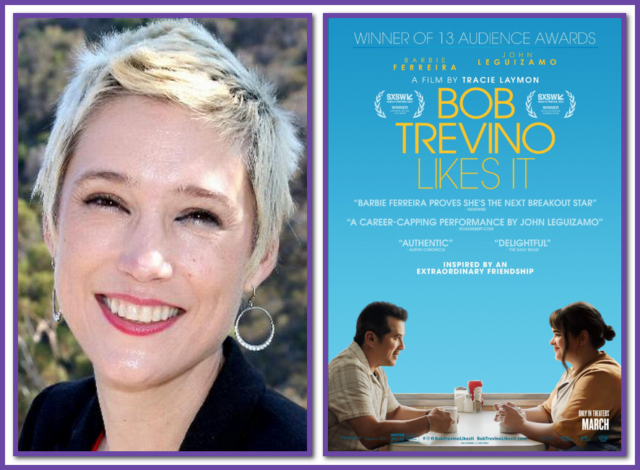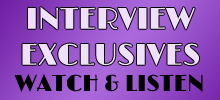
A moving and emotional exclusive interview with writer/director TRACIE LAYMON discussing the beautifully exquisite BOB TREVINO LIKES IT, a film inspired by the true friendship that writer/director TRACIE LAYMON found with a stranger in real life while looking for her father online. Side note to all: when you see the film, have tissues at the ready; lots and lots of tissues for both happy and sad tears.
SYNOPSIS: Often playing the role of caretaker to people like her father, who should be caring for her, Lily Trevino longs for familial connection. When her father, Robert, finally checks out of her life, Lily looks for him on the internet. She tries to “friend” a man she believes is her father on Facebook. But instead of finding Robert Trevino, she finds Bob Trevino instead. Bob Trevino works long hours at a construction company to support his wife Jeanie’s elaborate scrapbooking habit. The couple has endured a lot in the past decade, and Bob has prioritized his wife’s healing to the point of ignoring his feelings and sense of loneliness. When Bob gets an unexpected Facebook message from a stranger named Lily Trevino, he discerns she needs a friend as much as he does. Lily and Bob’s blossoming friendship becomes a vital source of connection and healing for both, holding the power to change each of their lives forever. Winner of an astounding thirteen film festival audience awards, BOB TREVINO LIKES IT retains the optimism that big tech can still provide human connection and that true friendship is a powerful kind of love and perhaps the family we need most in today’s world.
It’s long been said to write about what you know, and for many filmmakers, that also means making a film about something you know. In the case of TRACIE LAYMON, that’s exactly what she has done with BOB TREVINO LIKES IT. One of the most emotional films that I have ever seen, much of that is due to the chemistry between Barbie Ferreira and John Leguizamo as Lily and Bob, respectively. The depth of emotion in their performances is palpable. Important to Tracie was casting these characters based on heart rather than physical resemblance. Having watched Ferreira and Leguizamo, I can’t imagine any other actors in the roles of Lily and Bob. Exploring themes of kindness, trauma, and healing. BOB TREVINO LIKES IT is set within the confines of Tracie’s own experiences. Diving into the production aspect of the film, Tracie discusses the balance between analog and digital elements, the importance of creating a safe space for actors, and the personal catharsis she experienced during the filmmaking process.
Delving into the characters and the film’s thematics, Tracie explained that she never wanted to be “toxically positive” and knew she had to show the darkness to highlight the light. When portraying the cruel character of Robert (played by French Stewart in a show-stopping performance), she and Stewart deliberately avoided judgmental language and tried to humanize Robert. Her approach was to show that “hurt people, hurt people” without creating a caricature villain. Careful not to vilify her own father, whom the character was loosely inspired by, it was important to Tracie to demonstrate that healing comes from understanding, not complete condemnation. Focusing on showing nuance, through Lily, we can see that people have their own journeys and limitations and that Lily gets to choose her boundaries and potentially break generational patterns of hurt. By showing both the kindness of Bob and the cruelty of Robert, Tracie created a balanced narrative that explores how people can respond differently to trauma and pain, inviting empathy and understanding rather than simply painting characters as purely good or evil.
An interesting aspect of BOB TREVINO LIKES IT is the digital versus analog worlds. Lily and Bob connect via social media while Bob’s wife Jeanie is all analog in her approach to the world and in dealing with emotion. For Tracie, balancing analog and digital worlds was tricky but intentional. She didn’t want the film to be dominated by screens and wanted to show technology as a positive tool that can connect people. Her goal was to use digital communication as a portal to real-world connections. For the analog elements, like Jeanie’s scrapbooking, she drew inspiration from her childhood friend’s mother, who meticulously created scrapbooks, appreciating how physical scrapbooks preserve memories and make people feel loved and cherished, in contrast to digital content that can be easily deleted. Working closely with production designer Sydney Marquez, Marquez helped create tangible representations of these worlds, even bringing physical boards to her initial pitch, all of which helped Tracie show that digital technology isn’t inherently negative but can be a means of bringing people together in meaningful ways. As you will hear Tracie discuss, she specifically wanted to move beyond typical narratives about social media being scary or negative, instead showing how online connections can lead to genuine, transformative human relationships. The balance was about showing both the digital portal and the real-world experiences that emerge from those connections.
Much of what Tracie achieves in her thematic explorations and emotional resonance is due in large part to the visual grammar and work of cinematographer John Rosario. Approaching the visual grammar with a specific intention of creating a “feminine gaze” – not to exclude men, but to invite them into experiencing the characters’ emotional landscape, she and Rosario decided to focus every shot on what the characters are feeling or thinking, not just how they look with the aim being to make the cinematography feel like John was almost an actor in the scene. Using vintage lenses, frame rates were changed to heighten emotional moments, while wide-angle lenses were used for close-ups to convey the disorienting feeling of trauma. Important to Tracie was trying to help the viewers experience the characters’ internal worlds, particularly capturing the experience of someone like Barbie Ferreira’s character, Lily, who likely has CPTSD from childhood trauma. She explained that when you grow up with trauma, you become attuned to micro-shifts in personal dynamics, and she wanted the visual style to reflect that heightened emotional awareness. The ultimate goal was to create a visual language inviting viewers to be “a fly on the wall” in the characters’ lives, seeing and feeling their experiences intimately and authentically.
Working closely with editor Anisha Acharya, they faced the unique challenge of having “too many options” due to the incredible performances of their actors! Fortunate to have an editor who would be both honest and kind during the process, the primary editing goals were to preserve the emotional authenticity of the performances, balance humor and drama, create a pace that allows moments to breathe, and avoid making the film feel rushed. Using creative techniques like making typing sequences disjointed and incorporating voiceovers saved time versus delivering a film that could have easily been three hours long and packed with emotion and terrific performances. Grateful that this is an independent film, Tracie had more creative control and wasn’t pressured to make quick cuts or reduce emotional moments, which allowed the editing process to focus on the film’s emotional core – showing the nuanced mix of humor and drama that reflects how people actually experience life.
An interesting and thoughtful exclusive interview with writer/director TRACIE LAYMON,
TAKE A LISTEN. . .
by debbie elias, exclusive interview 03/04/2025
BOB TREVINO LIKES IT is now in select theatres.












